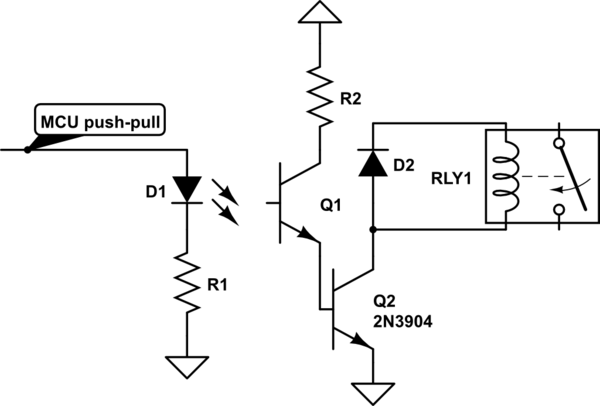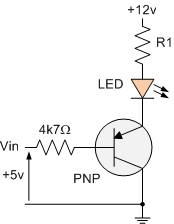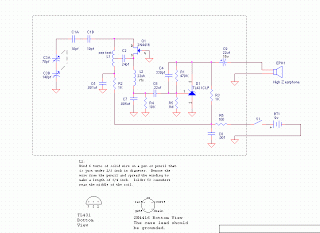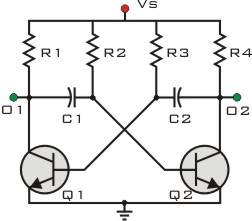
microcontroller driving a relay with transistor and Opto-isolator

Controlling a relay with an STM32 microcontroller involves using a 4N33 opto-isolator for electrical isolation. The relay coil requires approximately 250 mA, necessitating the use of an MPS222 transistor for switching. The GPIO configuration inverts the logic when used as the source voltage for the opto-isolator LED. A pull-up resistor is employed, connecting the other end of the LED to the GPIO. The GPIO operates in open-drain mode, allowing around 3 mA to flow through the pin. Currently, the R2 resistor is not grounded. The concern arises that if the STM32 becomes disconnected, the relay may inadvertently activate, which is undesirable. The inquiry is whether adding the R2 resistor will resolve this issue.
The circuit described involves the integration of a relay control system utilizing an STM32 microcontroller, a 4N33 opto-isolator, and an MPS222 transistor. The STM32 microcontroller is programmed to control the relay via its GPIO pins. The 4N33 opto-isolator provides necessary electrical isolation between the microcontroller and the relay circuit, ensuring that any high voltages or currents do not affect the microcontroller's operation.
In the circuit, the relay coil requires a current of approximately 250 mA to operate effectively. The MPS222 transistor acts as a switching device, allowing the current to flow through the relay coil when activated by the opto-isolator. The opto-isolator's LED is driven by a GPIO pin configured in open-drain mode, which means it can only pull the line low and requires an external pull-up resistor to pull the line high when the GPIO is not active.
The issue of the relay inadvertently activating when the STM32 is disconnected is a critical consideration in circuit design. The absence of the R2 resistor, which is intended to provide a path to ground, can lead to undefined behavior in the circuit, potentially allowing the relay to turn on due to stray voltages or floating states on the GPIO pin. By adding the R2 resistor and properly grounding it, the GPIO pin can be pulled to a defined low state when the microcontroller is disconnected, thereby preventing the relay from being activated unintentionally.
In conclusion, the addition of the R2 resistor is a recommended solution to mitigate the risk of the relay turning on due to disconnection of the STM32 microcontroller. Implementing this change will enhance the reliability and safety of the relay control circuit.Controlling a relay with stm32 micro controller. For the isolation I have used a 4N33 opto-isolator. As my relay coil needs around 250 mA, I used a mps222 transistor. I figured that the logic gets inverted when I used the gpio as the source voltage for the opto-isolator led. I just used a pull up instead and connected the other end of the led part to the gpio. Gpio is open drain, I will drain around 3mA in the pin. I do not have the R2 resistor grounded at this moment. My problem is if in case my stm gets disconnected then my relay will be turned on - which I want to avoid. Could anyone please tell me if adding this R2 will fix the issue 🔗 External reference
The circuit described involves the integration of a relay control system utilizing an STM32 microcontroller, a 4N33 opto-isolator, and an MPS222 transistor. The STM32 microcontroller is programmed to control the relay via its GPIO pins. The 4N33 opto-isolator provides necessary electrical isolation between the microcontroller and the relay circuit, ensuring that any high voltages or currents do not affect the microcontroller's operation.
In the circuit, the relay coil requires a current of approximately 250 mA to operate effectively. The MPS222 transistor acts as a switching device, allowing the current to flow through the relay coil when activated by the opto-isolator. The opto-isolator's LED is driven by a GPIO pin configured in open-drain mode, which means it can only pull the line low and requires an external pull-up resistor to pull the line high when the GPIO is not active.
The issue of the relay inadvertently activating when the STM32 is disconnected is a critical consideration in circuit design. The absence of the R2 resistor, which is intended to provide a path to ground, can lead to undefined behavior in the circuit, potentially allowing the relay to turn on due to stray voltages or floating states on the GPIO pin. By adding the R2 resistor and properly grounding it, the GPIO pin can be pulled to a defined low state when the microcontroller is disconnected, thereby preventing the relay from being activated unintentionally.
In conclusion, the addition of the R2 resistor is a recommended solution to mitigate the risk of the relay turning on due to disconnection of the STM32 microcontroller. Implementing this change will enhance the reliability and safety of the relay control circuit.Controlling a relay with stm32 micro controller. For the isolation I have used a 4N33 opto-isolator. As my relay coil needs around 250 mA, I used a mps222 transistor. I figured that the logic gets inverted when I used the gpio as the source voltage for the opto-isolator led. I just used a pull up instead and connected the other end of the led part to the gpio. Gpio is open drain, I will drain around 3mA in the pin. I do not have the R2 resistor grounded at this moment. My problem is if in case my stm gets disconnected then my relay will be turned on - which I want to avoid. Could anyone please tell me if adding this R2 will fix the issue 🔗 External reference





